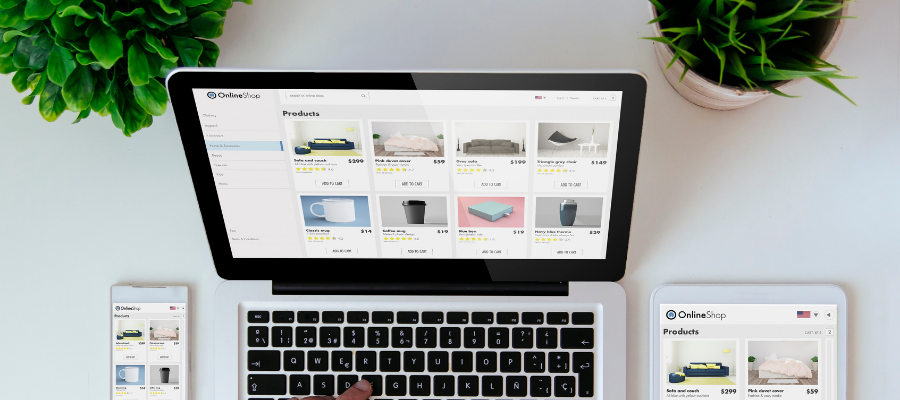With online sales expected to hit $6.5 billion by 2023 worldwide, the costs associated with setting up an ecommerce website may be a mystery to most. Now more than ever ecommerce is the fastest growing industry in the world. Many people have set up their own businesses and online shops, joining already established online sellers.
But how much does it cost to set up an ecommerce business? We’re diving into that question today. Exploring the different routes, the benefits and drawbacks of each and of course how much you can expect to pay for each.
Type of products
First, you’ll need to understand which platform or route you choose may already be influenced heavily by the type of products you sell.
Answer the following: is your product or service B2C (Business to Consumer) or B2B (Business to Business)? Either way, this will influence your marketing decisions due to your target market and should be the first question you answer.
Online or in-store
If you already have or are thinking about adding a brick and mortar shop to your ecommerce operation then there are some more aspects to consider. Both your brick and mortar shop and your ecommerce shop will need to flawlessly speak to each other. So stock levels don’t go out of sync, and leave wanting customers annoyed.
A good PoS (Point of Sale) system integration will be a vital part of your operation. So you need to ensure that this is included in your plans for costing your ecommerce shop. And always choose the best option for your business.
If you’re simply going the ecommerce route then a good inventory management system and fulfilment integration should help support your online shop operations to begin with.
Once you’ve decided if you’re going the online-only route or you’re opening a brick and mortar shop alongside it, the next step is to investigate which type of ecommerce platform is right for you.
Custom built site
One of the more expensive routes to go is to have a custom site built for you on a platform like Magento. Getting a custom site built for your exact requirements does sound like a great option as you’ll get everything you need from the get-go. But let’s take a look at the advantages and disadvantages of having a custom site built.
Advantages
Firstly, it’s completely flexible. As an open-source platform, you’ll be able to modify the source code to fit the needs of your business requirements – as and when you choose. It also allows for third-party integrations for things like importing products and more. Its flexibility is the biggest advantage of choosing this route.
As with most ecommerce options, it’s mobile optimised and scalable. Both are very important aspects to include when you’re researching what route is best for your business.
Disadvantages
However, a custom-built ecommerce solution like this doesn’t come without its drawbacks. Firstly, it can be very expensive. We’re talking about a couple of grand into the five-figure range depending on your requirements.
This is because a developer or developers are building your online shop and its functionality from the ground up. That’s a lot of work to begin with and can even cost more later down the line due to third-party fees if you can’t install extensions yourself, for example.
It can also be difficult to find authentic Magento developers. They need a complex understanding in order to have object orientated development and a vast experience. Even if you do find a good developer, chances are their prices are going to be sky high for a custom-built site.
It is also known to have slow loading times. Meaning customisations can be difficult to make in comparison to other ecommerce platforms. And if you choose this route initially and then decide you’d want to move to another ecommerce provider, switching can be challenging.
Lastly, it has bad product support. It can be quite expensive because most developers charge more for this compared to sites like WordPress.
All in all, whilst it has great potential when it comes to flexibility, the initial and ongoing costs may leave you in the negative and the lack of support may also hit your pockets. If you’re new to selling online, whilst the flexibility may be there, your budget (and technical experience) may not be.
Saas platform
Another popular option for selling online is through a SaaS (Software as a Service) platform, such as EKM. When starting out, most business owners choose this option for a variety of reasons. But let’s dive into the advantages and disadvantages.
Advantages
One of the best advantages, particularly for new businesses is the cost. An ecommerce platform like this splits the cost of everything you need for your online shop into monthly payments starting from £32.49 +VAT. This not only makes setting up an online shop really accessible but also reduces the amount of money invested in a new venture.
Some ecommerce platforms have pricing plans to help your business grow. At EKM, we provide you with the right support at the right time as your business grows.
Not only is this route low cost and has a low barrier to entry, but there are no hidden costs for features such as product urgency or shop emails. Most of what you’ll need to run a successful ecommerce business is included in the monthly price.
This includes things you may not think about like your hosting, domain, SSL certificate, payment gateways and so on. We’ll talk about these in more detail later on in the blog.
Support is also another great advantage of choosing a hosted ecommerce provider. Most if not all ecommerce platform providers will have some form of customer support. That could be in the form of a customer support team for general queries to a dedicated Account Manager. Only if your business needs an ecommerce expert who acts as an extension to your team.
You also have an entire company behind you, developing new features, integrations, partnerships, providing ecommerce support and advice, hosting and making sure that the platform adheres to all of the latest requirements for operation. This means you’ll have the power of many experts working knowledge behind you rather than a single developer.
Lastly, anyone can create a professional-looking ecommerce website or online shop using a SaaS platform. The groundwork is already done for you, just pick a website theme, brand colours, upload your logo and products adn you can start selling straight away.
Why not try EKM FREE for 14 days?
Disadvantages
Onto the disadvantages. If you’re a new business there are probably not going to be many disadvantages with an all-in-one platform. This is until you either require a very specific feature or functionality to your online shop that isn’t standard.
Specific features or functionalities that only you would need rather than the majority of online shops, are most likely not available due to the amount of development time, resource and lack of demand. But this is a rarity for most online shop owners.
There also may be some limitations on the amount of customisation you can do to your online shop due to it being on a hosted platform. Most of the time this isn’t a huge issue for most but it can crop up from time to time.
Lastly, you may need to use third-party integrations and platforms for some functionality such as for stock management across multiple platforms like eBay, Etsy and Amazon.
Marketplaces
Marketplaces are also another option available. Websites such as eBay, Etsy and Amazon all have a low barrier to entry. Just like a SaaS platform but also have their advantages and disadvantages.
Advantages
First of all one of the greatest advantages of using a Marketplace is that once you’re up and running, the traffic is directed to your online shop for you. The marketplace will already attract a large amount of traffic to its site, with customers looking for specific products and your products can easily be featured in their searches.
It can also be easier to grow and scale your ecommerce business on a marketplace. This will open up more opportunities for you to buy larger quantities of stock, get better prices from suppliers and increase your overall profit margin.
Their main advantage is the rate of traffic they can send to your shop, low cost and low barrier to entry. You’re also a little more protected as you will be working with and selling on a well known branded platform, which instills trust in your shop too.
Disadvantages
However, marketplaces aren’t for everyone.
One of the main drawbacks of a marketplace is that when someone buys from you and they’re asked to remember where they got the product from, they’re more likely to answer “oh Etsy” or “Amazon” rather than your brand name.
This can be damaging to your business as others who’ve been told this will search for the product on the marketplace and they may end up purchasing from one of your competitors. This takes business away from you and the best way to avoid this is to create your own online shop.
Another disadvantage is your products will be placed in the exact same search results as your competitors. And more likely than not, if a customer sees the same or similar product for less they’re more likely going to choose your competitor. A way to avoid this is to offer things like free shipping or if you can afford it, undercut them by a little.
And lastly, one of the biggest negatives of marketplaces is that they take a percentage of everything you make. These fees can not only be confusing as to how much they take, but it usually is quite a large chunk of your profit. So make sure that your pricing takes this into account. Whilst with your own online website, you’re able to pocket all of the profit.
Additional costs to consider
These main ways to get set up online are a good place to start when researching how much it costs to set up an ecommerce website. But there are also other costs to consider when shopping around for your perfect platform.
- Domain
Your website domain is free for the first year with EKM but can be an additional cost with some providers. You can always secure your own domain with a domain service but they tend to hook you in with super low prices for the first 12 months, and up the cost after that. You’ll also need to take time to attach your domain to your online shop, whatever platform you choose.
- Hosting
Hosting again, is another cost that can quickly increase if your shop is handling a lot of traffic. If it requires more power from the server, this can cost you more every month or year. With EKM, hosting is included within your monthly plan price.
Why not check out what else is included with EKM here?
You’ll want to set up a professional business email for your online shop or website, and some providers will also charge a monthly fee for this. You can sometimes buy your domain and email together so your shop URL matches. However, this is also something that will need renewing annually and you should expect an increase in cost.
- SSL certificates
Something every online shop or website should have to show and ensure that your customers’ data is secure. Particularly when using payment gateways where sensitive data is being inputted on your website. Some platforms and solutions do charge for this – with EKM it’s free for life.
- Payment processing costs
A benefit of working with a SaaS platform is that they will most likely have partnerships with the world’s largest payment providers and gateways. This means you’ll be able to get access to preferential rates for your chosen gateways transaction fees.
- Blog
A blog can have great long term SEO benefits for your online shop or ecommerce website. Whilst it can take time, the benefits of driving traffic to your blog and thus your online shop with relevant SEO driven content can be highly beneficial. Whilst some providers include an ecommerce blog within their price, some don’t. And that’s where you’d have to find a way to attach perhaps a WordPress blog to your online shop.
- Design
You may also require some branding and design work done for your new online shop. Without designing and creating these yourself, reaching out to a graphic designer can be costly. But you’re likely going to receive a very high level brand and design images for your ecommerce shop.
- Shipping costs
If you sell products online, shipping costs are going to be one of the more important aspects of figuring out your budget. Some platforms have integrations with shipping and delivery companies that make it easy to fulfil your orders. But make sure that you work out the costs for your products ahead of time.
- Storage
Lastly, if you either make your own products or source them from a supplier you’ll need somewhere to store them. If you don’t have any room at home, then a local storage solution is a good option if you can afford it. Otherwise you could always look into dropshipping products.
At the end of the day, you will need to decide what option is best for you based on your requirements, functionality needs as well as your effort level and budget.
Want a low cost, low effort route? Go for a marketplace.
Have all the money in the world? Go for a custom built ecommerce website.
Want to build your own brand and have complete control but with low cost? Go for a SaaS platform like EKM.
It all depends, but let us know how you chose which route to take in the comments!
If you’d like to learn more about setting up your own online shop, read on for more insights into running your own online business here.








